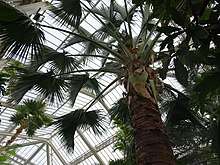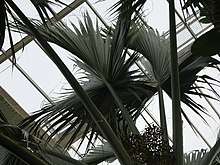Sabal domingensis
Sabal domingensis, the Hispaniola palmetto, is a species of palm which is native to Hispaniola and Cuba.
| Sabal domingensis | |
|---|---|
 | |
| At Botanic Garden Meise | |
| Scientific classification | |
| Kingdom: | Plantae |
| Clade: | Tracheophytes |
| Clade: | Angiosperms |
| Clade: | Monocots |
| Clade: | Commelinids |
| Order: | Arecales |
| Family: | Arecaceae |
| Genus: | Sabal |
| Species: | S. domingensis |
| Binomial name | |
| Sabal domingensis | |
| Synonyms | |
|
Sabal neglecta Becc. | |
Description
Sabal domingensis is a fan palm with solitary, very stout stems, which grows up to 10 metres (33 ft) tall and 60 centimetres (24 in) in diameter. Plants have 20–30 leaves, each with about 90 leaflets. The inflorescences, which are branched, arching and at least as long as the leaves, bear pear-shaped, black fruit. The fruit are 1–1.4 centimetres (0.4–0.6 in) in diameter; fruit size and shape are the main characteristics by which this species differs from Sabal causiarum.[1]
Common names
Sabal domingensis is known as the "Hispaniola palmetto", "Hispaniola palm", or "Dominican palm" palma cana in the Dominican Republic and latanier-chapeau in Haiti.[1]
Distribution
Sabal domingensis is found from northwest Haiti to the central Dominican Republic, and is also present in Cuba. It is usually found in secondary vegetation between 100 and 1,000 metres (328 and 3,281 ft) above sea level.[1] This palm also grew in Puerto Rico also harvested in Barrio Canas, in Ponce, Puerto Rico, as early as the early 1800s for making sombreros. Barrio Canas was given that name in 1831 because of the extensive growth of this palm there during the years of the colonization of Puerto Rico.[2]
Uses
The leaves are used for thatch and to weave a variety of items including hats, baskets and mats.[1]

References
- Henderson, Andrew; Gloria Galeano; Rodrigo Bernal (1995). Field Guide to the Palms of the Americas. Princeton, New Jersey: Princeton University Press. ISBN 978-0-691-08537-1.
- Verdadera Y Auténtica Historia de la Ciudad de Ponce. Eduardo Neumann Gandia. Instituto de Cultura Puertorriqueña. 1913. Page 71. Accessed 16 June 2018.
External links
- Sabal Domingensis Info Floridata